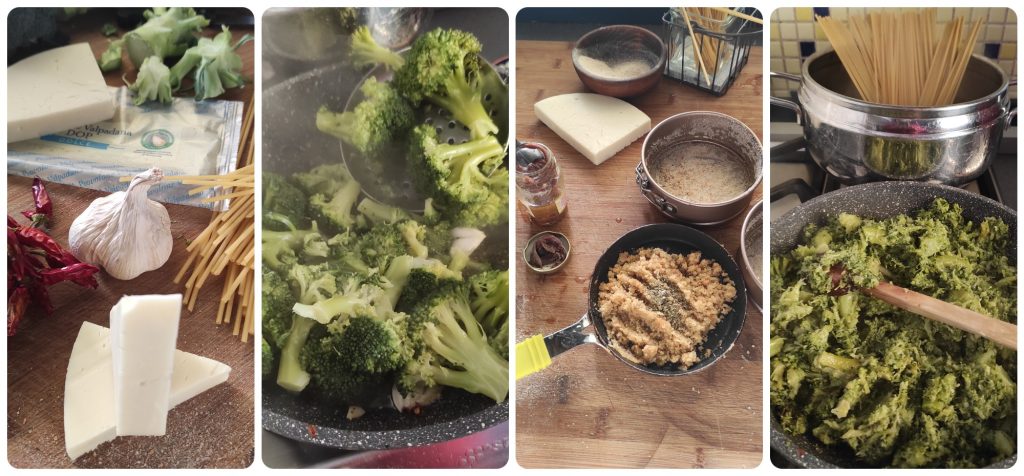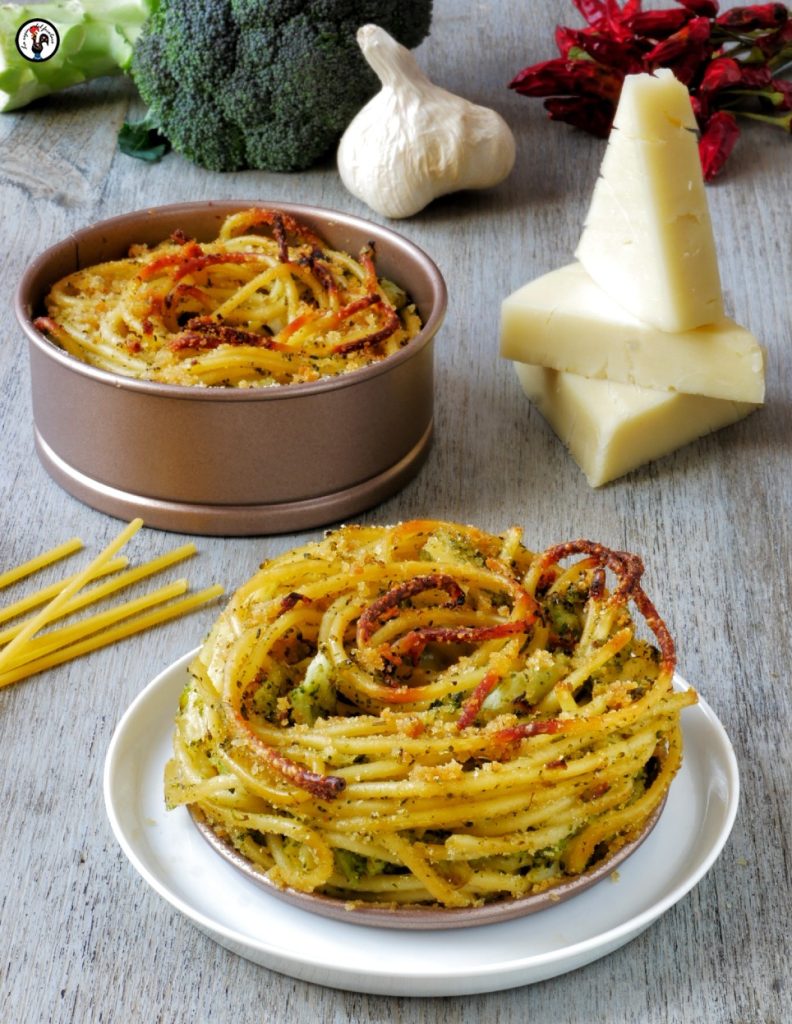The baked bucatini and broccoli pie, enriched with mild provolone and seasoned breadcrumbs, is a Sicilian baked recipe without béchamel. It is one of the many variations of pasta with broccoli that is cooked in countless ways in Southern Italy. Today’s presentation is very elegant: small individual portions or, if you prefer, real bucatini nests with a melting heart of Provolone Val Padana DOP. So why did I cook a typically Southern pasta with cheese from the Po Valley and not use caciocavallo or even primo sale? There are two reasons.
Thanks to AIFB (Italian Food Blogger Association), I participated in an interesting webinar about Provolone Val Padana DOP, complete with tasting. I discovered that this spun cheese has ancient origins, and its ancestor is indeed caciocavallo. The story is long, but it ends like this: there was a time in Italian history when the South was so poor that it no longer even had milk. So, the master cheesemakers emigrated (the word is exactly that) to the North, settling in the Po Valley. There were plenty of pastures and water, and they also brought their expertise. This is how a new cheese was born, similar to caciocavallo but not the same, as it was deeply tied to the territory. Mild provolone is the perfect cheese for my recipe: soft and enveloping, it is flavorful but not overpowering and perfectly complements the taste of broccoli and anchovy.
Food also raises thousands of questions, and I asked myself why this combination. Where do my roots lie, first as a woman and then as a cook? Who am I today and what do I express with my recipe? A part of my family (and my cooking) comes from Palermo: this root is strong in my heart and consequently in my dishes; however, the other root, that of the family from Northern Italy where I was born, is equally strong. It is from my territory that the products I use come: I make pasta with broccoli with mild provolone.
Thus, my dish proudly tells both the story of my family and that of the Southern master cheesemakers who came North. The milk of the Po Valley, the rennet, and everything else. Broadly speaking, the baked bucatini and broccoli pie represents all of Italy. Beautiful.
If you like broccoli, check out:
• Sicilian Pasta with Broccoli
• Broccoli Stem Pesto – Anti-waste Recipe
- Difficulty: Easy
- Cost: Economical
- Preparation time: 30 Minutes
- Portions: 6
- Cooking methods: Boiling
- Cuisine: Regional Italian
What you need for the baked bucatini and broccoli pie
- 5.3 oz bucatini
- 1.1 lbs broccoli florets
- 7 oz provolone (Provolone Val Padana DOP, mild)
- 2 fillets anchovies in oil
- 1 clove garlic
- 1 chili pepper (small)
- 3.4 oz extra virgin olive oil
- 3.5 oz breadcrumbs
- 1 tsp salt
From today you can receive all the new recipes on the Telegram channel of my blog. It’s free, and to subscribe, you just need to open this link: this way, you’ll always be updated on recipes, secrets, tips, and news. You can receive all the recipes on your phone, without risking missing any and without needing to enter any phone number or email address; if you wish to leave the channel, just delete it.
What you need to prepare the baked bucatini pie
You need a springform pan, preferably non-stick, to avoid breaking the beautiful crust that will form.
I used two individual molds for a stylish plating, suitable even for Valentine’s Day. These small molds come in all kinds, and for incurable romantics, even heart-shaped.
Let’s prepare the bucatini, broccoli, and provolone pie together
Before we start, however…
Choose your taste, sweet or spicy, only from Europe is a great project promoted by the Consorzio Tutela Provolone Valpadana and co-financed by the European Commission. It aims to help everyone recognize this cheese and learn to buy and consume it better, more consciously. It helps us understand what a European quality product is. The Provolone Valpadana, the project’s ambassador, encompasses a lot in terms of values, commitment, work, and excellence. All this, in short, is the DOP label: three simple letters representing a story and a world.
The Italian Food Blogger Association (AIFB) has partnered with this three-year project. Indeed, the love for excellent raw materials, the care in handling them, and the awareness of the story they tell make each dish not just a recipe, but a real narrative. This is what every food blogger tries to do, sharing a bit of themselves in each preparation.
Clean the broccoli by removing the stems, which can later be used to make an excellent pesto. Boil them briefly in plenty of salted water, the same in which we will cook the bucatini. Then drain the broccoli florets al dente and toss them in a pan, where we will have prepared a base of oil, anchovy, garlic, and chili pepper.
While the vegetables are gaining flavor, prepare the toasted bread, known as atturrato: take a small pan and pour in the bread, generously season with oil, salt, and oregano, and let it toast without burning. Then set it aside.
Cut the mild provolone into small pieces, but keep some larger ones to create the soft center of the pie.
Finally, cook the bucatini for 4 minutes: half of the cooking time.


Now we have everything we need. Grease a 9-inch springform pan or, if you’re romantic like me, two small individual ones. Then sprinkle them with breadcrumbs.
Drain the bucatini al dente and mix them directly in the pan with the broccoli (remember to remove the garlic cloves and chili pepper if used whole). Add the toasted bread, not all at once but gradually; the bucatini should be sandy. Also, add the mild provolone cut into pieces. Then, using a fork, arrange the bucatini in the pan to form a nest. In the center, add some pieces of the cheese we reserved. Finally, sprinkle with some seasoned breadcrumbs and a small coil of pasta to close.For the final crust: a bit of bread, a grating of provolone or hard cheese, and a drizzle of oil.
Our individual pies are ready; they will bake in a preheated oven at 350°F for 15 minutes.
Once cooked, they should be browned and crispy on the top, bottom, and sides, but the center should remain soft and gooey.
The Queen’s Tips
The choice of individual portions is not just for romantic reasons. The special thing about this pie is its adorable crust, which makes it different from other preparations with similar ingredients. The individual portion, in short, will allow everyone to enjoy a lot of adorable crunchiness. Be careful with cooking, though: if we overdo it, the pasta would be dry, and that’s not what we want.
For the toasted bread, originally, flaky breadcrumbs were used, well seasoned and toasted. Once cold, it can be further crumbled by hand. It will inevitably remain more rustic and coarse but is delicious: the choice between breadcrumbs and this is yours. And if the bread should remain, don’t throw it away! It will be delicious with spaghetti aglio, olio, and peperoncino.
Finally, the pasta pie is also good cold the next day.
Return to the HOME to learn more about me by reading Who I am, discover Vegetarian Dishes, Liguria Recipes, Sicilian ones and all the good things that the Queen in the kitchen prepares.
Follow me on Facebook, on Instagram, and now also on Telegram: you’ll never run out of ideas for dinner again!
Note: this recipe contains affiliate links.

